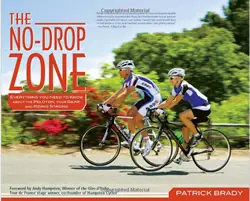Below is an excerpt from the book "The No-Drop Zone: Everything You Need to Know About the Peloton, Your Gear, and Riding Strong" by Patrick Brady. The 250-page book outlines all aspects of road cycling for beginners, from riding skills to bike gear to the cycling lifestyle. Learn more about the book here.
Descending uses the same countersteering technique you use to corner. It adds to this an extra dimension in speed. To control your bike at speed, you need a position that blends great control and aerodynamics. The ideal position is a tuck with your head low, your rear in the saddle, your hands in the drops, and your cranks level.
As your speed increases, so does the minimum radius of any turn you make. Put another way, the faster you go, the bigger the arc. For this reason you need to choose your position in the lane before entering a turn.
For a right-hand turn, set up as close to the center yellow lines as possible before entering the turn. Once you enter the turn, aim for the apex, the actual corner to your right; as you pass the apex, gradually allow yourself to swing back out to the yellow lines, thus giving you the gentlest line through the corner and allowing you to carry maximum speed.
For left hand turns, the process works just the opposite; set up as close to the edge of the road as possible and then apex at the center yellow lines followed by a swing back to the right edge.
Former pro cyclist Joe Parkin says, "I like to keep my elbows bent and actually bend them more as I get closer to the apex. As I come out of the corner, I allow myself to sit up just a bit more. Using your inside leg as an outrigger of sorts helps get your bike and body set up for S-turns too—tossing the knee toward the corner really helps re-weight everything before entering into the turn."
Make your turn as smooth as possible, because sudden turns or adjustments to your course can cause you to lose traction. You can use these same apexing techniques for corners you take above 20 miles per hour.




